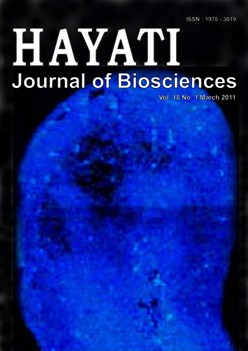<strong><span style="font-size:9pt;line-height:115%;">The human feet and mouth are known as sources of methylated sulfides, which are produced by other microflora. Methylated sulfides could be oxidized by methylotrophic bacteria, which may result in odor reduction in human feet and mouth. In this study, we collected a total of 21 isolates from human feet, and 37 isolates from human mouth. These isolates were identified with biochemical test such as oxidase and catalase test and Gram staining assay. The presence of <em>mxaF</em> gene of methanol dehydrogenase was detected by PCR using specific primers. However, the result showed that most of the isolates did not possess <em>mxaF</em> gene. Hence, the methanol dehydrogenase (MDH) activity was also determined. From the total 21 isolates obtained from the feet, only 15 of them showed MDH activity whereas 23 isolates from the total 37 isolates obtained from teeth and tongue region also showed MDH activity. Isolate K25-3 (74.444 U/ml), K33-6 (79.815 U/ml), and K43-5 (69.259 U/ml) from human feet and M41L3 (135.926 U/ml), M27G2 (85.556 U/ml), and M51G1 (103.333 U/ml) from human mouth showed the highest total enzyme activity. Isolates with the highest total activity could be used for further studies such as purification of the enzyme and isolates characterization.</span></strong>
Abstract
The human feet and mouth are known as sources of methylated sulfides, which are produced by other microflora. Methylated sulfides could be oxidized by methylotrophic bacteria, which may result in odor reduction in human feet and mouth. In this study, we collected a total of 21 isolates from human feet, and 37 isolates from human mouth. These isolates were identified with biochemical test such as oxidase and catalase test and Gram staining assay. The presence of mxaF gene of methanol dehydrogenase was detected by PCR using specific primers. However, the result showed that most of the isolates did not possess mxaF gene. Hence, the methanol dehydrogenase (MDH) activity was also determined. From the total 21 isolates obtained from the feet, only 15 of them showed MDH activity whereas 23 isolates from the total 37 isolates obtained from teeth and tongue region also showed MDH activity. Isolate K25-3 (74.444 U/ml), K33-6 (79.815 U/ml), and K43-5 (69.259 U/ml) from human feet and M41L3 (135.926 U/ml), M27G2 (85.556 U/ml), and M51G1 (103.333 U/ml) from human mouth showed the highest total enzyme activity. Isolates with the highest total activity could be used for further studies such as purification of the enzyme and isolates characterization.Downloads
HAYATI J Biosci is an open access journal and the article's license is CC-BY-NC. This license lets others distribute, remix, tweak, and build upon author's work, as long as they credit the original creation. Authors retain copyright and grant the journal/publisher non exclusive publishing rights with the work simultaneously licensed under a https://creativecommons.org/

























.png) IPB University
IPB University Department of Biology
Department of Biology The Indonesian Biological Society
The Indonesian Biological Society 

